Different Types of Literature Reviews and Their Importance
If you’ve ever started a research project or thesis, you’ve probably come across the term literature review. But what exactly is it, and why is it so important in academic writing? Simply put, a literature review is a detailed summary and critical analysis of existing literature research, theories, findings, and discussions on a particular topic. Think of it as doing your scholarly homework before joining a conversation that’s already happening among experts.
Why do you need a literature review in fields like healthcare, social sciences, business, technology, or education? Because it helps you understand what’s already out there, identify gaps in knowledge, and avoid repeating what others have already explored. It also gives your research a strong, evidence-based foundation to build on.
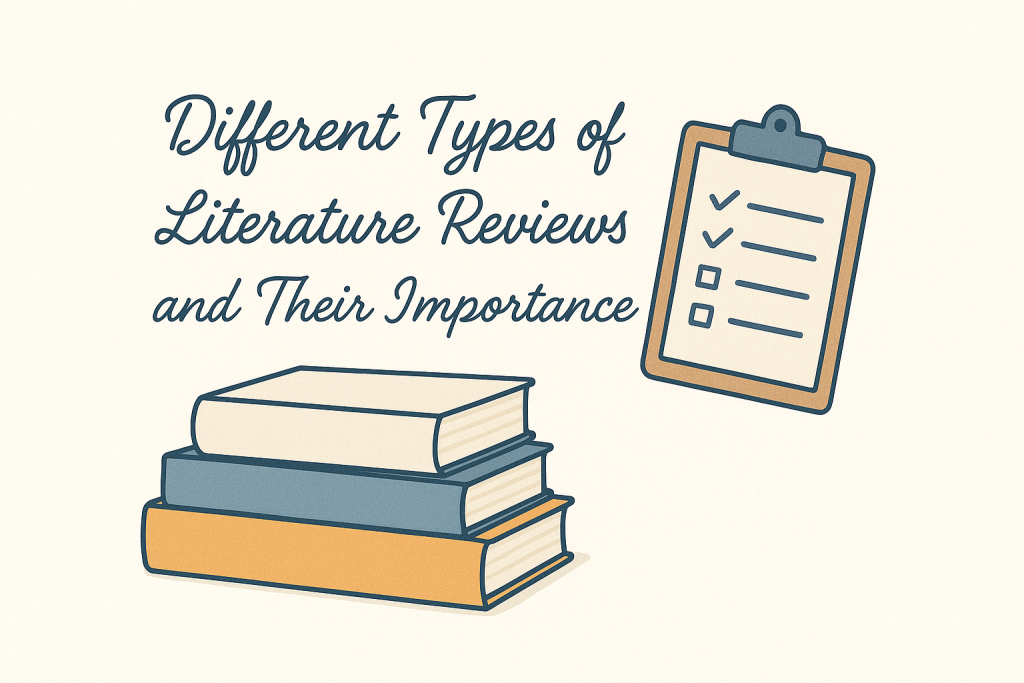
So, what type of literature review should you use for your project? In this blog post by Finewriters.co.uk, we’ll walk you through 14 different types of literature reviews, when to use them, and how each one can enhance the impact of your academic work. Let’s dive in!
The Value of Literature Reviews in Research
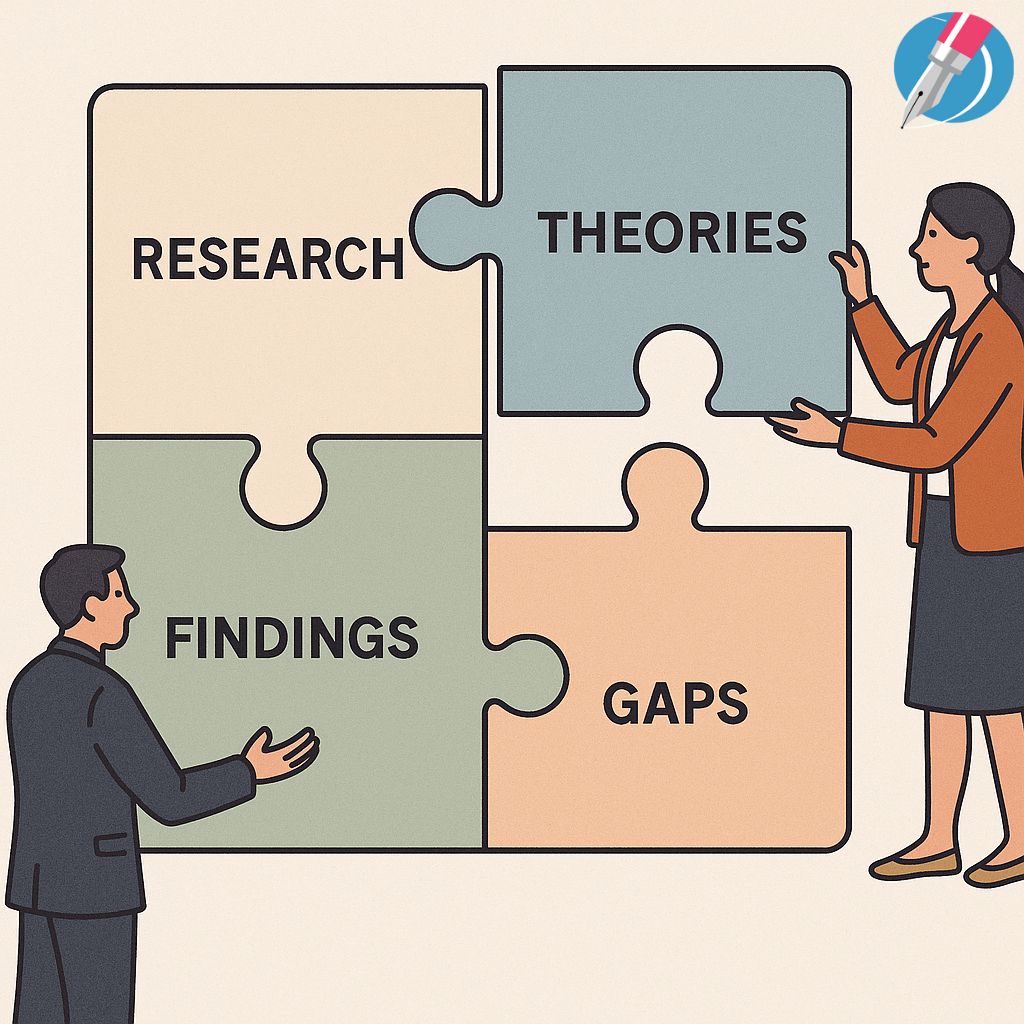
Ever wonder why every serious research project begins with a literature review? It’s not just a formality, it’s a game-changer. A well-crafted literature review helps you identify gaps in existing literature research so you’re not just reinventing the wheel. Instead of repeating what’s already done, you get to build on current knowledge and take things in a fresh direction. It shows you what’s missing, what’s controversial, and where your research can make a difference.
Beyond avoiding redundancy, literature reviews are also crucial for theory-building and choosing the right research methodology. They help you figure out what theoretical frameworks have been used, which ones worked (or didn’t), and how you can adapt or challenge them. You’re essentially learning from past research mistakes and successes before diving into your own project. That’s a win.
Need to put your research into context? A literature review does that, too. It helps you see the bigger picture—how your study fits into the wider academic conversation. Whether you’re writing a dissertation, publishing it in a journal, or pitching a proposal, having that contextual understanding gives your work depth and direction.
From students to scholars, from professionals to policymakers, literature reviews are essential. They’re the foundation of evidence-based practice across disciplines. No matter your field—whether it’s healthcare, business, education, or tech—a solid literature review sets the stage for credible and impactful research.
And if you’re not sure which type of literature review to use, don’t worry—we’ve got you covered in the next section.
Detailed Exploration of 14 Types of Literature Reviews
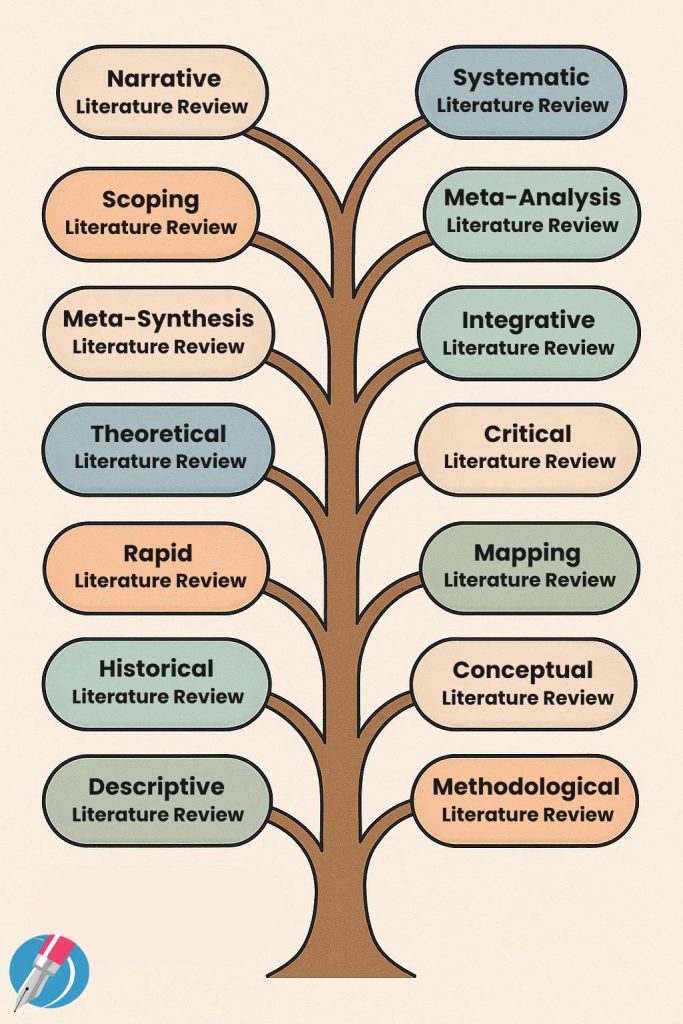
To make things easier, let’s go over some common types of literature reviews you might come across or need to use. Each one has its own purpose and works best for certain kinds of research. Whether you’re writing a dissertation, thesis, or journal article, knowing these types can really help improve your work.
Narrative Literature Review
A narrative literature review gives a general overview or summary of the work that’s already been done in your area of study. Unlike other types of reviews, it doesn’t follow a strict method. It’s mainly used to explore theories, spot trends, or get a basic understanding of a topic. This type of review is often used at the start of a research project or when you’re building the background for your study. The downside is that it can be biased since there aren’t clear rules about what to include or leave out. Still, it’s a popular choice, especially in subjects like social sciences and humanities.
Systematic Literature Review
If you’re looking for something super thorough and well-organized, the systematic literature review is the way to go. It carefully goes through the process of finding, selecting, and studying research using a clear set of rules. Researchers decide what to include and what to leave out, which helps keep things fair and reliable. This method reduces bias and is often used in fields like health, education, and public policy.
But there’s a catch—it takes a lot of time and attention to detail. Still, if you want a clear, high-quality summary of the best studies out there, this is a great option. It’s perfect for research that needs strong, evidence-based results.
Scoping Literature Review
When it comes to understanding a topic in a broad and detailed way, a scoping literature review can be super helpful. Instead of checking how good each study is, this type of review looks at all the research available to get the full picture. It’s great for spotting new or less-studied areas that are still developing, especially when the definitions and ideas around them aren’t fully settled yet.
Scoping reviews help with things like shaping your research questions, figuring out what’s already known (and what’s not), building a base for future research, or even preparing for a more detailed systematic review. They’re often used in fields like health, education, and environmental studies that combine ideas from different areas.
While scoping reviews are flexible and good for exploring, they don’t go deep into judging the quality of each study—so they’re not the best choice if you’re trying to make solid, final conclusions.
Meta-analysis Literature Review
If you’re working with a bunch of quantitative (numbers-based) studies and want to see the overall picture, a meta-analysis is the way to go. It combines results from different studies using stats to find patterns or big-picture trends. This is super helpful in fields like medicine and psychology, where there’s lots of data. The big plus? You get more powerful results by pulling together findings from multiple studies. But for it to work well, the studies need to be similar and have good-quality data. If they’re too different, the results might not make much sense.
Meta-synthesis Literature Review
This one is kind of like the meta-analysis, but for qualitative research—stuff based on interviews, experiences, or opinions. A meta-synthesis takes different studies and looks for themes or patterns in what people are saying or experiencing. It’s popular in fields like nursing, education, and psychology, where understanding personal stories and viewpoints really matters. The goal isn’t to shrink the info down but to create new meaning by combining what others have found. Just keep in mind—it’s based on interpretation, so being clear and honest about how you reached your conclusions is important.
Integrative Literature Review
If you want to bring together both theoretical ideas and actual data—from quantitative and qualitative studies—then an integrative review is your best bet. It gives a complete picture by mixing different kinds of research and is great for areas like healthcare, nursing, or any topic that crosses multiple subjects. You can pull out new ideas, compare concepts, or build new frameworks. The tricky part? It takes time and care to bring it all together in a way that makes sense.
Theoretical Literature Review
If your research is more about concepts and ideas than numbers or case studies, a theoretical literature review will help. It looks at existing theories, models, and frameworks to build a solid base for your own ideas. This is common in fields like education, social sciences, and philosophy. It helps you define terms, understand different viewpoints, and maybe even build your own model. The downside? You need to have a strong understanding of the theories you’re working with.
Critical Literature Review
This one goes beyond just summarizing past research—it’s all about asking “How well was this done?” A critical literature review digs deep into methods, points out flaws, and shows where there are gaps in knowledge. It’s often used in advanced dissertations or high-level research. It takes more time and brainpower because you need a sharp understanding of the topic. But if done right, it can lead to fresh insights and really move your research forward.
Rapid Literature Review
In a rush? A rapid literature review is a faster version of a systematic review. It’s perfect when decisions need to be made quickly—like in health emergencies, policy-making, or fast-moving tech fields. It skips some steps (like deep quality checks or wide searches), but still keeps things clear and reliable. The trade-off is that you won’t get as much detail, but it works well when you need solid info quickly.
Mapping Literature Review
A mapping literature review gives you the big picture. It helps you visually or thematically organize literature to see what’s out there and where the gaps are. Rather than diving deep into content, this literature review focuses on categorizing studies by topic, methodology, or research outcomes. It’s common in emerging disciplines or interdisciplinary research where understanding the structure of existing work is more important than critical appraisal. Charts, graphs, or even conceptual diagrams are often included to make findings easy to grasp. It’s perfect for scoping broad fields or when you’re trying to plan a future study with precision.
Historical Literature Review
Want to know how a concept has evolved over time? A historical literature review does just that. This type tracks the development of theories, debates, or practices throughout history. It’s incredibly useful when you need to show how academic thought has shifted, especially in philosophy, education, law, or political science. You get to trace influential studies, breakthroughs, and even controversies that shaped the field. This kind of literature review gives your research historical context and a timeline of how things got to where they are today. Just be sure to keep it relevant and connected to your current research focus.
Conceptual Literature Review
A conceptual literature review helps you get crystal clear on what key terms and ideas really mean. It explores how different researchers define, use, and interpret concepts, especially when there’s confusion or inconsistency in the literature. This type is super useful during the early stages of research, especially in areas where definitions are still being debated. You’ll often see conceptual literature reviews in psychology, education, and theoretical frameworks. The main goal is to bring clarity and refine understanding. It may not provide empirical findings, but it’s gold when you need to build or strengthen your theoretical foundation.
Descriptive Literature Review
Need a simple overview of what’s been said so far? A descriptive literature review might be what you’re looking for. It summarizes key findings from various studies in a neutral, non-evaluative way. There’s no deep analysis or critique—just a straightforward presentation of who did what and what they found. This type of literature review is great for introductions, background sections, or when you’re new to a topic and want to get your footing. It’s not designed to challenge ideas or dig into gaps, but it offers a clean and clear snapshot of the existing body of literature research.
Methodological Literature Review
If your focus is on how research is conducted rather than what it found, then a methodological literature review is the way to go. It analyzes and compares the research methods, techniques, and tools used across multiple studies. This literature review type is especially useful when designing your own study—you can see what works, what doesn’t, and what trends are emerging. It’s commonly used in social sciences, education, and public health. One of its biggest strengths is guiding your methodology decisions with evidence. Just be ready to engage with technical details and assess how methods impact outcomes.
Comparative Summary: Choosing the Right Type
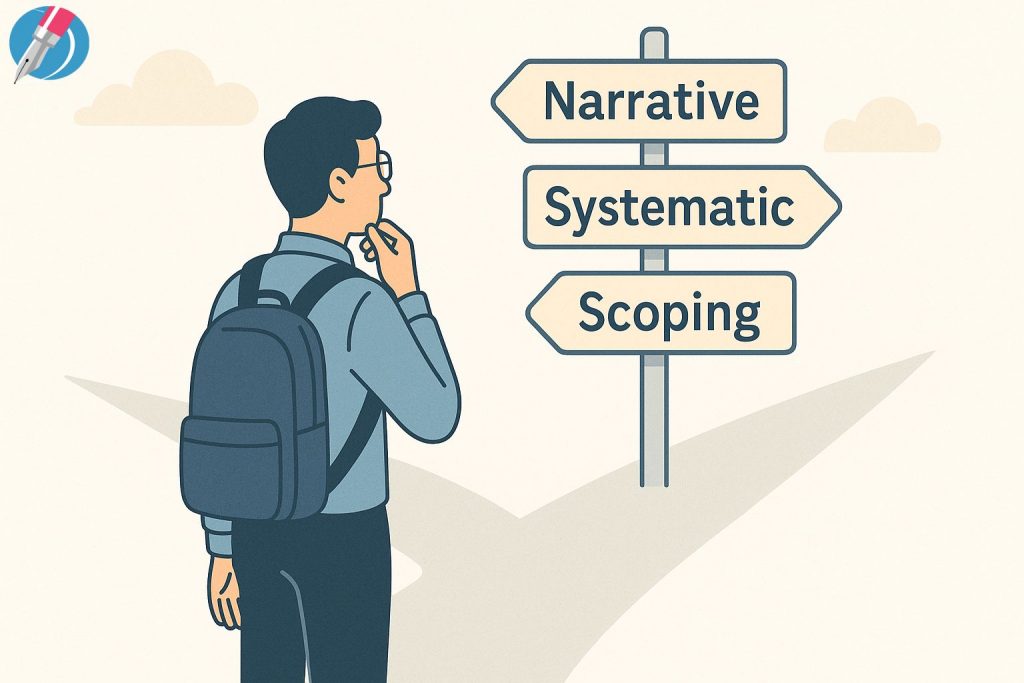
With so many types of literature reviews out there, how do you know which one to choose? It all comes down to your research purpose. If you’re writing a thesis, a systematic literature review might give your work the depth it needs. If you’re exploring new territory, a scoping or conceptual literature review could be more suitable. Writing a grant proposal? A rapid or narrative literature review can help you build a strong case quickly. For policy research, a meta-analysis or integrative literature review might offer the comprehensive evidence base needed. The key is understanding the methodological fit matching your literature review type to the scope, timeline, and goals of your study. This thoughtful choice can save time and boost your research impact.
Practical Implications for Researchers and Students
Choosing the right literature review type enhances the credibility, structure, and clarity of your work. Whether you’re writing a dissertation, journal article, or research proposal, a well-matched literature review supports your arguments and strengthens your foundation. It also helps you stand out as a thoughtful and informed researcher in your field.
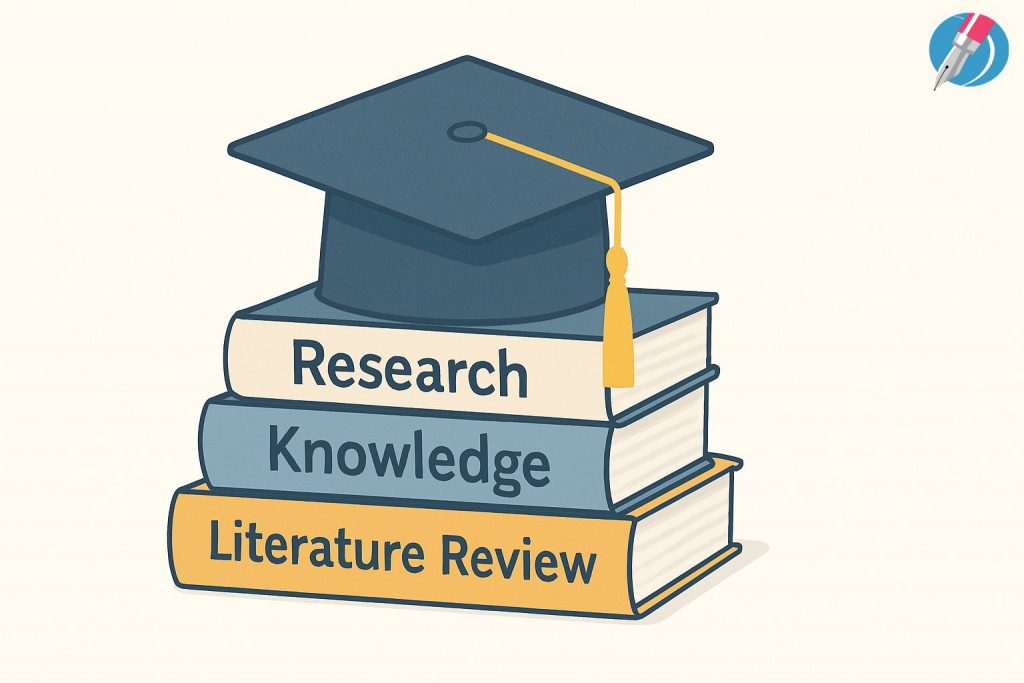
Conclusion
Picking the right type of literature review isn’t just helpful—it’s essential. Align your literature review with your research objectives, and you’ll be one step closer to producing truly impactful academic work.
